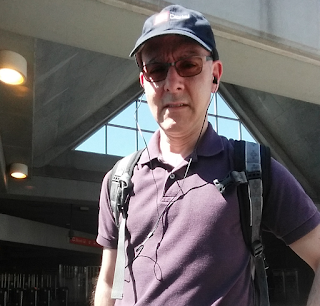Bridge inferno, collapse highlights metro ATL’s vulnerability
 |
| I-85 bridge collapse hacked! That's me taking MARTA instead of driving into Atlanta, GA's downtown. |
As most of us know, the March 30th I-85 North
bridge collapse made challenging traffic situations even worse in metropolitan
Atlanta. This vital link of roadway forces thousands of commuters and travelers
alike onto the few alternative routes available thus making our already-awful
traffic conditions into a nightmare of epic proportions. This debacle took over
our television airwaves as viewers watched in amazement as a federal road
burned to the ground. Much is being debated as to who started the inferno as
well as why in the world were there materials stored under the bridge that
could have accelerated the fire. “Atlanta burning” made national and world
headlines once again, but the unfortunate event showed that this could happen
anywhere.
I’m about to get a bit too local here, but this is the
scenario taking place with I-85 out of commission. Those traveling I-85 north
must exit at the Buford-Spring Connector, a four-lane thoroughfare that
parallels I-85 for several miles. For me, that road has always been a great
alternative most of the time if I chose to skip going up the Downtown Connector
which is where I-85 meets I-75 for many miles in Atlanta – horrendous idea by
the way. The Buford-Spring Connector is great most of the time – except for now
since everyone must exit onto this roadway. Before the I-85 collapse, one could
travel 50 mph. After the collapse, it is down to about 15 mph.
Going southbound on Buford-Spring is similar even with one
of its lanes closed now. I suppose that lane remains closed for construction equipment
to have room to operate. While speaking about construction of the new part of
I-85, the demolition of the damaged freeway was competed in just one week while
the state Department of Transportation says that the entire project will be
done by mid-June.
Getting local again, someone like me is a regular commuter
from the northeast suburbs to Atlanta’s downtown area. Like thousands of other
commuters, I travel from Georgia’s Gwinnett County into Atlanta’s downtown area
through my work week. My choice is to
either drive completely around the city to get to downtown via I-285 East to
I-75 South or take public transportation. I’m choosing to do both. I work one
weekend morning so I can use I-285 and I-75 without much hassle – only more
fuel and automobile wear and tear. During the week when traffic is far heavier,
I’m on the MARTA rail, Atlanta’s public transportation offering. The agency
also offers bus service.
In the aftermath of the bridge collapse, there has been a
lot of talk about finding alternative routes and work hours, telecommuting,
carpooling and using mass transit. These ideas are wonderful, but to me, metro
Atlanta and perhaps most of the country, are resistant to these ideas. For the
most part, we are still stuck in the 9-5 Monday through Friday
business-as-usual mode with mostly solo vehicle commuters. Certainly,
adjustments have been made after a portion of I-85 “went offline.” MARTA
ridership is up along with some work/school hour adjustments and telecommuting,
but as we creep up to the day when 85 goes “back online,” it will be back to
business-as-usual. To change any of this scenario, we need to re-design our
thinking when it comes to moving from Point A to Point B. In the meantime, the
US is still a car-loving, solo-driving culture and that’s unfortunate. We waste
time and energy commuting, not to mention how it is bad for our health,
environment and business.
The bridge burning and subsequent collapse highlights the
area’s bad road design and vulnerability. All it takes is a chink in the area’s “road
armor,” and the entire system falters. There are few alternatives and “back-ups”
to the entire infrastructure. Perhaps we all learned from this mess, but I have
my doubts. We have short memories indeed.
Comments